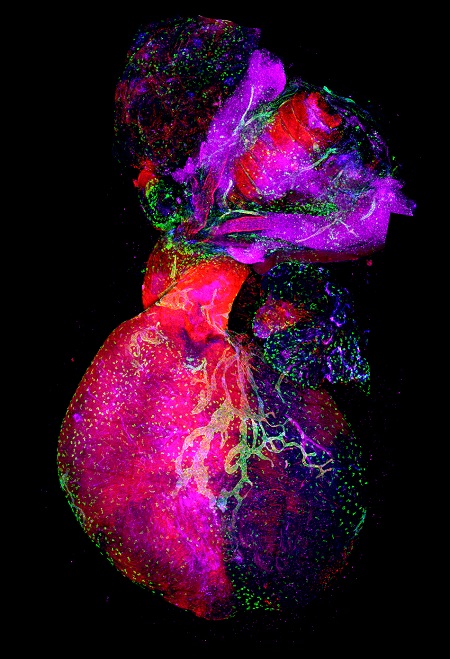Development Cell: An international study discovers a new origin of lymphatic vessels in the heart
The international team led by CNIC researchers Drs Miguel Torres and Ghislaine Lioux found that the cardiac lymphatic vasculature does not have a single origin, but is instead formed by cells originating in a variety of tissues
An international study led by Drs Miguel Torres and Ghislaine Lioux of the Centro Nacional de Investigaciones Cardiovasculares (CNIC), has identified and characterized a new vasculogenic niche that contributes to the development of the cardiac lymphatic system. The study shows that the coronary lymphatic vessels have varied origins and functions: the results of the study reveal that the coronary lymphatic vasculature does not have a single origin, but instead forms through the participation of cells from different tissues.
The study, published in Development Cell, opens the way to future research into the mechanism underlying lymphatic vasculogenesis in this new niche and the functional diversity of coronary lymphatics.
The coronary circulation, essential for heart function, is not only composed of the arteriovenous system that provides oxygen and nutrients, but also includes lymphatic vessels. The essential functions of the cardiac lymphatic vessels include protecting the heart against infection, preventing edema (fluid retention) in the myocardium, and the recovery of cardiac function after an infarction. Despite its importance, the coronary lymphatic vasculature is little understood and has received much less attention than the coronary arteries and veins.
This international study was led by Dr Miguel Torres’s group at the CNIC in partnership with Dr Guillermo Oliver’s group at the University of Chicago, Dr Robert Kelly at the University of Marseilles, and Dr Sagrario Ortega at the Centro Nacional de Investigaciones Oncológicas (CNIO). The study examines the origin of the coronary lymphatic system during the formation of the heart in the mouse embryo.
Until now, explained Dr Torres, all lymphatic vessels were believed to develop from cells derived from the major veins of the early embryo, from where they migrate to colonize all the tissues and organs in the embryo.
The study published in Development Cell opens the way to future research into the mechanism of lymphatic vessel formation in this new niche and the functional diversity of cardiac lymphatics
The new study shows that, in the heart, there is a second population of lymphatic cells that is recruited later during development and is derived not from veins, but from a region called the second heart field.
The second heart field, explained Ghislaine Lioux, is composed of multipotent cells “able to generate different types of heart cells, including cardiomyocytes (the cells of the cardiac muscle), smooth muscle cells, and the endothelial cells of the arteries and veins.”
The study shows that the repertoire of cells generated by the second heart field is wider than previously thought and also includes the lymphatic endothelium. According to Dr Torres “this unique feature of the coronary lymphatic vasculature opens up several interesting avenues for future research.”
One of the more surprising findings of the research was that lymphatic cells from the second heart field mix with lymphatic cells with a different, likely venous, origin, with the two populations together forming the lymphatic vessels of the ventral part of the heart
One of the more surprising findings was that lymphatic cells generated in the second heart field mix with lymphatic cells with a different, likely venous, origin; the two populations together form the lymphatic vessels in the ventral part of the heart.
Although the second heart field contributes only 50% of the cells of the lymphatic vessels, blockade of their formation completely prevented the formation of the coronary lymphatic vasculature.
This result indicates that the newly discovered cell population not only contributes a large proportion of the cells of the coronary lymphatic system, but also leads a specific and irreplaceable process in the formation of the coronary lymphatic vasculature. “This function reveals, for the first time, the specialization of endothelial subpopulations in the formation of the coronary vasculature and opens the way toward a better understanding of the formation of lymphatic vessels, a process essential not only for embryonic heart development but also for the response of the heart to stress and disease in adulthood.”











